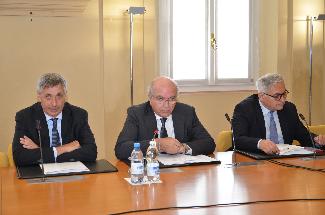
The Italian ceramic industry recorded revenues of ?8.7 billion in 2022
Tile sales totalled €7.2 billion in value and 449 million square metres in volume. Exports accounted for more than 83% of total sales at €6 billion
At its Members’ Meeting held this afternoon (14th June 2023), Confindustria Ceramica unveiled the 2022 figures for the segments of ceramic tiles and slabs, ceramic sanitaryware, porcelain and tableware, refractory materials, technical ceramics, and bricks and roof tiles. The Italian ceramic industry as a whole consists of 259 companies with 26,500 direct employees and revenues of €8.7 billion. Manufacturing operations in Europe and North America by subsidiaries of Italian ceramic companies generate a total value in excess of €1 billion. The Members’ Meeting elected the association’s Board of Directors for the two-year period 2023-2025 and was concluded with a speech given by Emilia-Romagna regional governor Stefano Bonaccini.
Italian-made ceramic tiles
There were a total of 128 ceramic tile companies operating in Italy in 2022 with a production of 431.2 million square metres (down 0.9% on 2021) and a workforce of 18,639 direct employees, similar to the previous year’s figure. Total sales amounted to 448.9 million square metres (-1.4%). Sales in Italy exceeded 92.7 million sqm (+1.7%), while exports reached 356.2 million sqm (-2.2%). Italian tile producers reported total revenues of almost €7.2 billion (+16.5%), of which €6 billion was generated by exports (+14.8%; 83% share of turnover) and €1.2 billion from sales in Italy. Investments totalled €441.3 million, an increase of 25.6% over 2021, and represented 6.1% of turnover.
Ceramic sanitaryware
There were a total of 30 ceramic sanitaryware manufacturers operating in Italy in 2022, including 27 located in the Civita Castellana cluster in the province of Viterbo. The industry employed a total direct workforce of 2,652 people nationwide and produced 3.6 million pieces. Turnover totalled €396.9 million, including €156.8 million from exports (40% of the total).
Refractory materials
Italy’s 30 refractory materials producers employed 1,639 people and produced a total of 301,100 tons of products. Total turnover fell compared to the previous year (€373 million, -2%) as a combined result of more than €151 million of domestic sales and more than €222 million of exports.
Bricks and roof tiles
The Italian brick and roof tile industry consists of 62 companies with a workforce of 3,000 employees and 2022 revenues of €700 million, mainly generated from domestic sales. Production totalled 4.6 million tons.
Ceramic tableware
The 9 industrial-level Italian companies operating in the sector employed a total of 654 people and reported a production of 9,900 tons and sales of 9,400 tons of finished products. Domestic sales accounted for 75% of the total. Total 2022 turnover amounted to €60.1 million (+27%), about 63% of which was generated in Italy.
Statement by Giovanni Savorani, Chairman of Confindustria Ceramica
“Over the last few years we have been witnessing a series of extraordinary historical events. Last year saw the initial months of the Russian invasion of Ukraine, while this year the Romagna region has been experiencing disastrous flooding. An event of unimaginable proportions, it claimed 15 lives, devastated entire provinces and even brought some of our companies’ production activities to a halt for a few days, although they have now all resumed operation.
“Export volumes fell by 25% in the first quarter of 2023 across all markets. Italian domestic sales volumes also fell, albeit by less than 10%. Export revenues likewise declined by around 13%, whereas Italian sales revenues grew by a few percentage points. A return to lower values was fairly predictable following the extraordinary performance of the first six months of 2022, although the contraction was mainly caused by dramatic changes in the international scenario including a sudden rise in interest rates, persistently high inflation, the end of the post-lockdown boom in consumption, and worsening consumer confidence. In this context, international competition is becoming increasingly fierce and the Italian and European industries are watching very closely to ensure that fair trading practices are followed by all exporters, including those from India and China.
“The fall in gas and electricity prices is a positive development, although structural problems remain unresolved, such as the absence of implementing decrees aimed at increasing domestic gas extraction by 2 billion cubic metres for use by intensive gas consumer sectors, and an ETS reform that is bound to further aggravate the competitive disadvantages of EU industry. Although the ETS scheme was set up with the commendable goal of decarbonisation, it has proved to be ineffective and counterproductive in terms of improving the environment. It has also had a recessionary effect on industry, with current CO2 prices hovering around €85 per tonne compared to €25 in June 2019. The Fit for 55 plan aimed at achieving a structural reduction in emissions is also having an adverse impact on the competitiveness of our industry given that our factories have already achieved the highest possible levels of efficiency and alternative technological solutions do not at present appear viable.
“As for infrastructure, I would first like to welcome the work on the Modena to Sassuolo railway line aimed at eliminating the level crossing on the Pedemontana road, the feasibility project for the third bridge over the River Secchia designed to improve short-haul traffic flows, and the investments aimed at increasing the maximum draft at the port of Ravenna and building two railway stations directly at the docks.
“On the other hand, there has been a lack of progress on the Campogalliano-Sassuolo link road, on the widening of the single-lane section of the Pedemontana road in Sassuolo, and the rail link between the Marzaglia and Dinazzano freight yards. All of these works are urgently needed to improve our industry’s overall competitiveness and to complete the roadworks that are essential for improving the quality and safety of passenger and goods transport.”